This document proposes a scheme for ensuring data integrity and dependability for cloud storage systems. The scheme utilizes erasure coding to distribute data across multiple servers and generate verification tokens to enable lightweight auditing. It allows users to efficiently audit that their data is intact and to identify any misbehaving servers. The scheme also supports secure dynamic operations like updates, deletes and appends while maintaining the same level of integrity assurance. Analysis shows the scheme is efficient and resilient to various security threats from malicious servers.
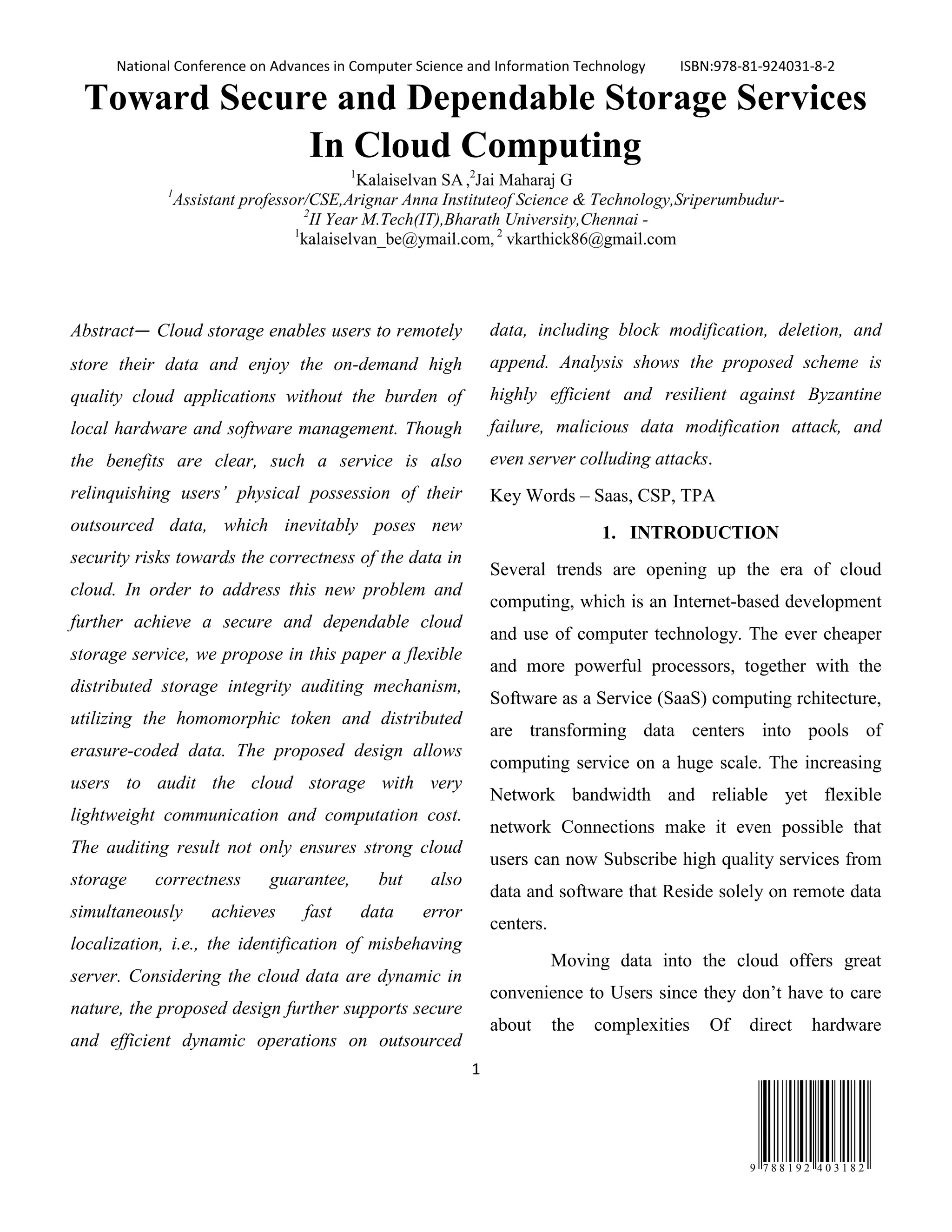
![National Conference on Advances in Computer Science and Information Technology ISBN:978-81-924031-8-2
2
9 7 8 8 1 9 2 4 0 3 1 8 2
management. The pioneer of cloud Computing
vendors, Amazon Simple Storage Service (S3), and
Amazon Elastic Compute Cloud (EC2) [2] are both
well-known examples. While these internet-based
online services do provide huge amounts of storage
space and customizable computing resources, this
computing.
• C. Wang is with the Department of Electrical
and Computer Engineering, Illinois Institute of
Technology, 1451 East 55th St., Apt. 1017 N,
Chicago, IL 60616. E-mail: cwang55@iit.edu. .
• Q. Wang is with the Department of Electrical
and Computer Engineering, Illinois Institute of
Technology, 500 East 33rd St., Apt. 602,
Chicago, IL 60616. E-mail: qwang38@iit.edu..
• K. Ren is with the Department of Electrical and
Computer Engineering, Illinois Institute of
Technology, 3301 Dearborn St., Siegel Hall
319, Chicago, IL 60616. E-mail:
kren@ece.iit.edu. .
• N. Cao is with the Department of Electrical and
Computer Engineering, Worcester Polytechnic
Institute, 100 Institute Road, Worcester, MA
01609. E-mail: ncao@wpi.edu. .
• W. Lou is with the Department of Computer
Science, Virginia Polytechnic Institute and State
University, Falls Church, VA 22043. E-mail:
wjlou@vt.edu.
Manuscript received 4 Apr. 2010; revised 14 Sept.
2010; accepted 25 Dec. 2010; published online 6
May 2011. For information on obtaining reprints of
this article, please send e-mail o:tsc@computer.org
and reference IEEECS Log Number TSCSI-2010-
04-0033. Digital Object Identifier no.
10.1109/TSC.2011.24. platform shift, however, is
eliminating the responsibility of local machines for
data maintenance at the same time. As a result,
users are at the mercy of their cloud service
providers (CSP) for the availability and integrity of
their data [4]. On the one hand, although the loud
infrastructures are much more powerful and reliable
than personal computing devices, broad range of
both internal and external threats for data integrity
still exist. Examples of outages and data loss
incidents of noteworthy cloud storage services
appear from time to time [5], [6], [7], [8], [9]. On
the other hand, since users may not retain a local
copy of outsourced data, there exist various
incentives for CSP to behave unfaithfully toward
the cloud users regarding the status of their
outsourced data. For example, to increase the profit
margin by reducing cost, it is possible for CSP to
discard rarely accessed data without being detected
in a timely fashion [10]. Similarly, CSP may even
attempt to hide data loss incidents so as to maintain
a reputation [11], [12], [13]. Therefore, although
outsourcing data into the cloud is economically](https://image.slidesharecdn.com/s-150310051744-conversion-gate01/75/S-A-kalaiselvan-toward-secure-and-dependable-storage-services-2-2048.jpg)
![National Conference on Advances in Computer Science and Information Technology ISBN:978-81-924031-8-2
3
9 7 8 8 1 9 2 4 0 3 1 8 2
attractive for the cost and complexity of long-term
large-scale data storage, its lacking of offering
strong assurance of data integrity and availability
may impede its wide adoption by both enterprise
and individual cloud users.
In order to achieve the assurances of cloud
data integrity and availability and enforce the
quality of cloud storage service, efficient methods
that enable on-demand data correctness verification
on behalf of cloud users have to be designed.
However, the fact that users no longer have physical
possession of data in the cloud prohibits the direct
adoption of traditional cryptographic primitives for
the purpose of data integrity protection. Hence, the
verification of cloud storage correctness must be
conducted without explicit knowledge of the whole
data files .Meanwhile, cloud storage is not just a
third party data warehouse. The data stored in the
cloud may not only beaccessed but also be
frequently updated by the users including insertion,
deletion, modification, appending, etc. Thus, it is
also imperative to support the integration of this
dynamic feature into the cloud storage correctness
assurance, which makes the system design even
more challenging. Last but not the least, the
deployment of cloud computing is powered by data
centers running in a simultaneous, cooperated, and
distributed manner [3]. It is more advantages for
individual users to store their data redundantly
across multiple physical servers so as to reduce the
data integrity and availability threats. Thus,
distributed protocols for storage correctness
assurance will be of most importance in achieving
robust and secure cloud storage systems. However,
such important area remains to be fully explored in
the literature.
Recently, the importance of ensuring the
remote data integrity has been highlighted by the
following research works under different system
and security models. These techniques, while can be
useful to ensure the storage correctness without
having users possessing local data, are all focusing
on single server scenario. They may be useful for
quality-of-service testing ,but does not guarantee
the data availability in case of server failures.
Although direct applying these techniques to
distributed storage (multiple servers) could be
straightforward, the resulted storage Verification
overhead would be linear to the number of servers.
As an complementary approach, researchers have
also proposed distributed protocols for ensuring
storage correctness across multiple servers or peers.
However, while providing efficient cross server
storage verification and data availability insurance,
these schemes are all focusing on static or archival
data. As a result, their capabilities of handling
dynamic data remains unclear, which inevitably](https://image.slidesharecdn.com/s-150310051744-conversion-gate01/75/S-A-kalaiselvan-toward-secure-and-dependable-storage-services-3-2048.jpg)
![National Conference on Advances in Computer Science and Information Technology ISBN:978-81-924031-8-2
4
9 7 8 8 1 9 2 4 0 3 1 8 2
limits their full applicability in cloud storage
scenarios.
In this paper, we propose an effective and
flexible distributed storage verification scheme with
explicit dynamic data support to ensure the
correctness and availability of users’ data in the
cloud. We rely on erasure correcting code in the file
distribution preparation to provide redundancies and
guarantee the data dependability against Byzantine
servers [26], where a storage server may fail in
arbitrary ways. This construction drastically reduces
the communication and storage overhead as
compared to the traditional replication-based file
distribution techniques. By utilizing the
homomorphic token with distributed verification of
erasure-coded data, our scheme achieves the storage
correctness insurance as well as data error
localization: whenever data corruption has been
detected during the storage correctness verification,
our scheme can almost guarantee the simultaneous
localization of data errors, i.e., the identification of
the misbehaving server(s). In order to strike a good
balance between error resilience and data dynamics,
we further explore the algebraic property of our
token computation and erasure-coded data, and
demonstrate how to efficiently support dynamic
operation on data blocks, while maintaining the
same level of storage correctness assurance. In
order to save the time, computation resources, and
even the related online burden of users, we also
provide the extension of the proposed main scheme
to support third-party auditing,
Fig. 1. Cloud storage service architecture.
Where users can safely delegate the integrity
checking tasks to third-party auditors (TPA) and be
worry-free to use the cloud storage services. Our
work is among the first few ones in this field to
consider distributed data storage security in cloud
computing. Our contribution can be summarized as
the following three aspects: 1) Compared to many
of its predecessors, which only provide binary
results about the storage status across the distributed
servers, the proposed scheme achieves the
integration of storage correctness insurance and
data error localization, i.e., the identification of
misbehaving server(s). 2) Unlike most prior works
for ensuring remote data integrity, the new scheme
further supports secure and efficient dynamic](https://image.slidesharecdn.com/s-150310051744-conversion-gate01/75/S-A-kalaiselvan-toward-secure-and-dependable-storage-services-4-2048.jpg)
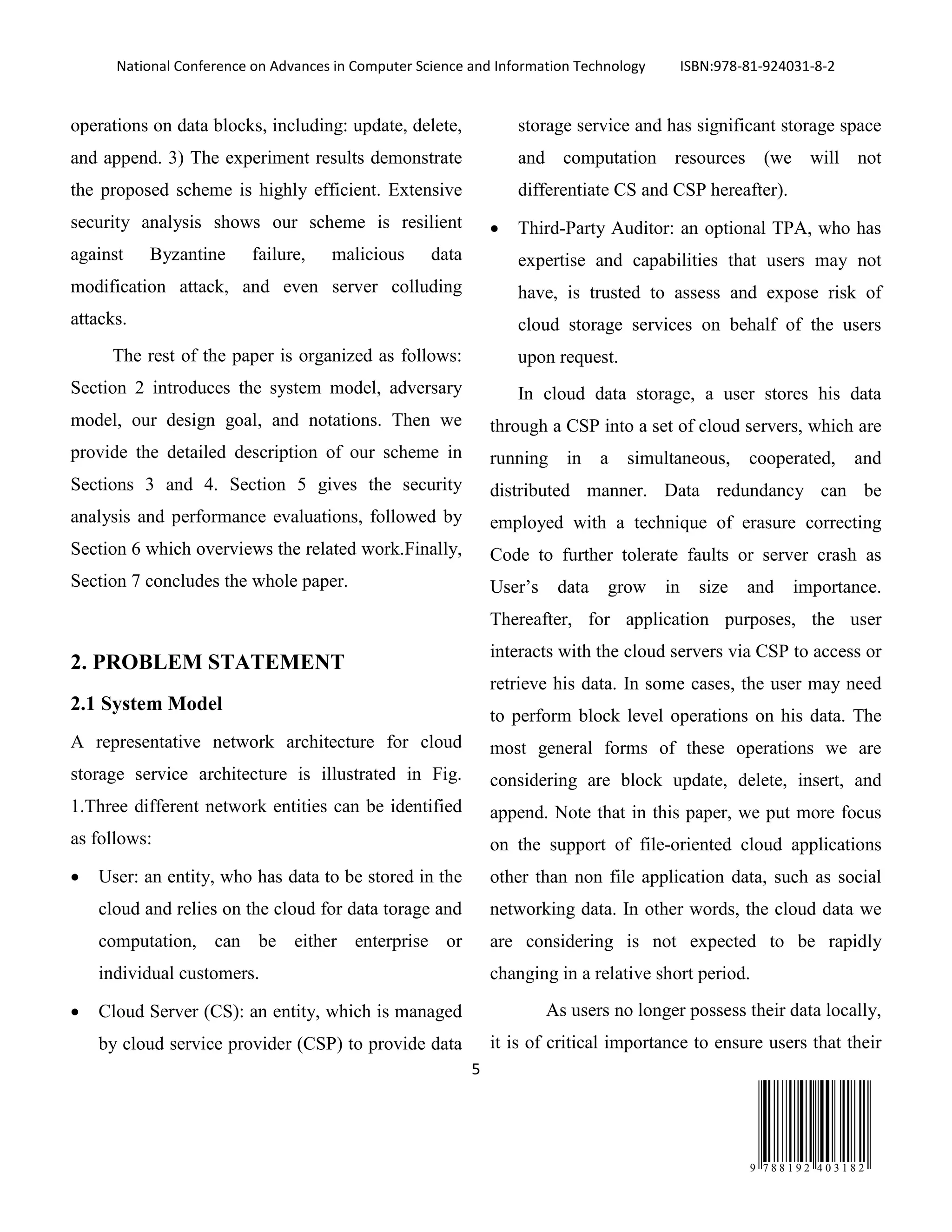
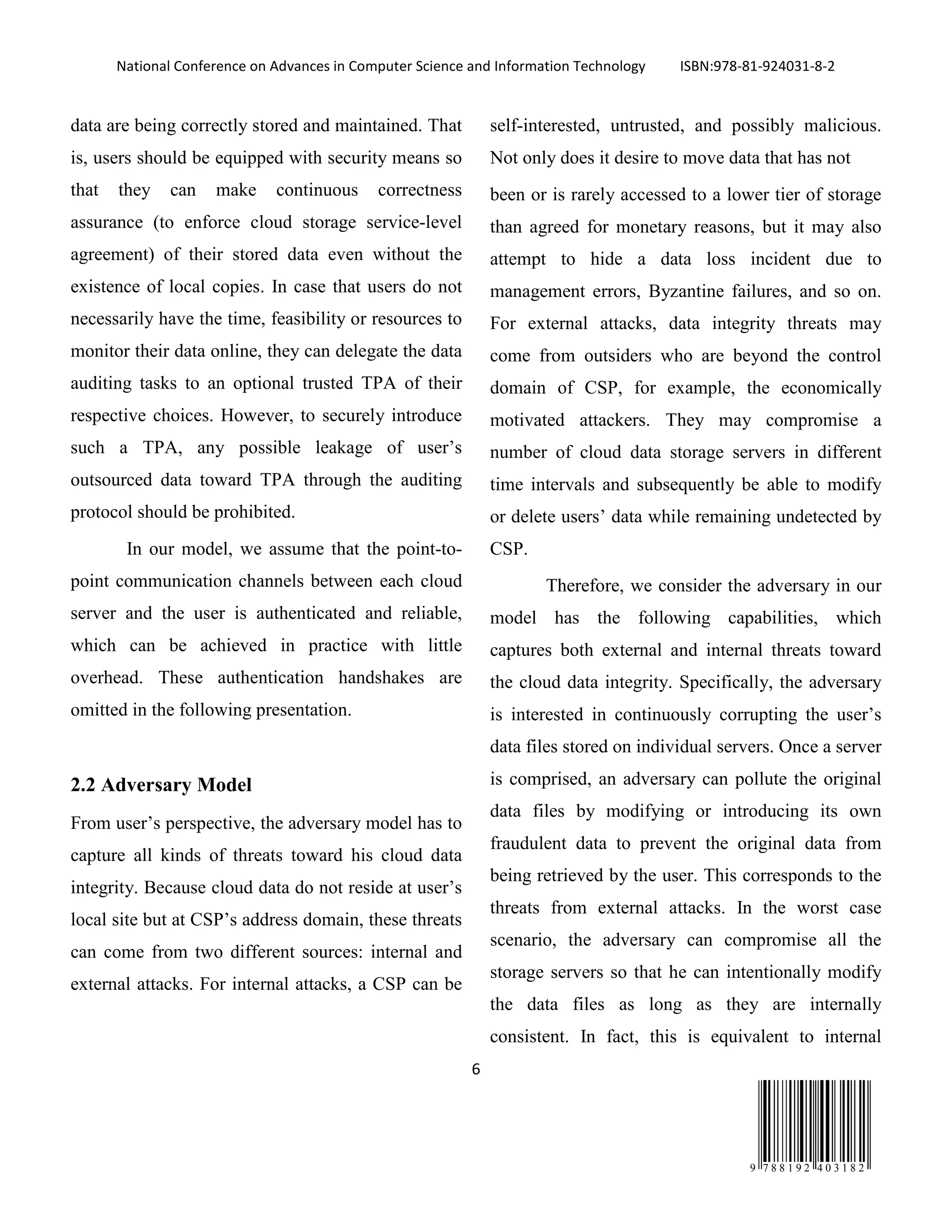
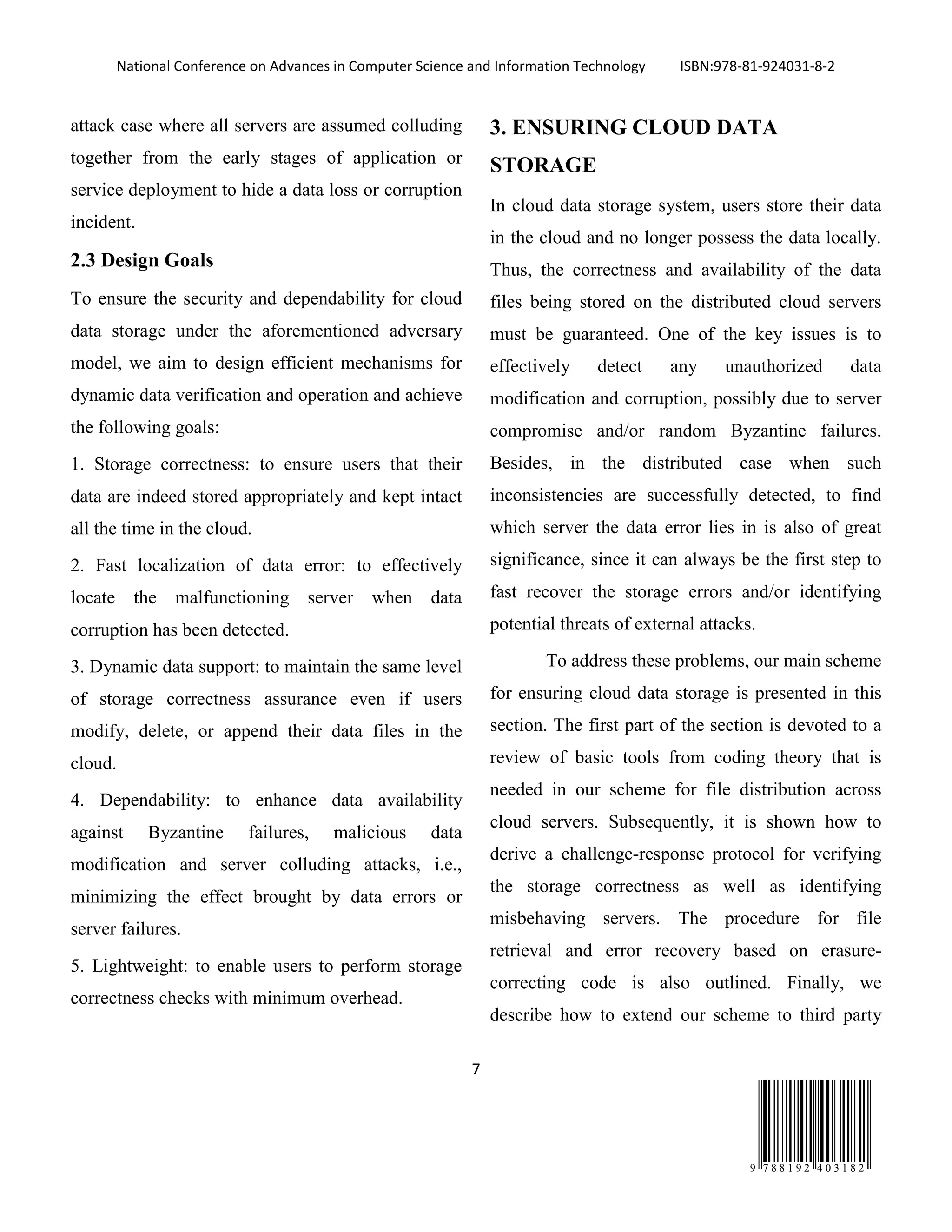
![National Conference on Advances in Computer Science and Information Technology ISBN:978-81-924031-8-2
8
9 7 8 8 1 9 2 4 0 3 1 8 2
auditing with only slight modification of the main
design.
3.1 File Distribution Preparation
It is well known that erasure-correcting code may
be used to tolerate multiple failures in distributed
storage systems. In cloud data storage, we rely on
this technique to disperse the
data file F redundantly across a set of n ¼ m þ k
distributed servers. By placing each of the m þ k
vectors on a different server, the original data file
can survive the failure of any k of the m þ k servers
without any data loss, with a space overhead of
k=m. For support of efficient sequential I/O to the
original file, our file layout is systematic, i.e., the
unmodified m data file vectors together with k
parity vectors is distributed across m þ k different
servers.
3.2 Challenge Token Precomputation
In order to achieve assurance of data storage
correctness and data error localization
simultaneously, our scheme entirely relies on the
precomputed verification tokens. The main idea is
as follows: before file distribution the user
precomputes a certain number of short verification
tokens on individual vector each token covering
a random subset of data blocks. Later, when the
user wants to make sure the storage correctness for
the data in the cloud, he challenges the cloud
servers with a set of randomly generated block
indices. Upon receiving challenge, each cloud
server computes a short “signature” over the
specified blocks and returns them to the user. The
values of these signatures should match the
corresponding tokens precomputed by the user.
Meanwhile, as all servers operate over the same
subset of the indices, the requested response values
for integrity check must also be a valid codeword
determined by the secret matrix P.
Suppose the user wants to challenge the
cloud servers t times to ensure the correctness of
data storage. After token generation, the user has
the choice of either keeping the precomputed tokens
locally or storing them in encrypted form on the
cloud servers. In our case here, the user stores them
locally to obviate the need for encryption and lower
the bandwidth overhead during dynamic data
operation which will be discussed shortly.
3.3 Correctness Verification and Error
Localization
Error localization is a key prerequisite for
eliminating errors in storage systems. It is also of
critical importance to identify potential threats from
external attacks. However, many previous schemes
[23], [24] do not explicitly consider the problem of
data error localization, thus only providing binary
results for the storage verification. Our scheme
outperforms those by integrating the correctness](https://image.slidesharecdn.com/s-150310051744-conversion-gate01/75/S-A-kalaiselvan-toward-secure-and-dependable-storage-services-8-2048.jpg)
![National Conference on Advances in Computer Science and Information Technology ISBN:978-81-924031-8-2
9
9 7 8 8 1 9 2 4 0 3 1 8 2
verification and error localization (misbehaving
server identification) in our challenge-response
protocol: the response values from servers for each
challenge not only determine the correctness of the
distributed storage, but also contain information to
locate potential data error(s). Specifically, the
procedure of the ith challenge-response for a cross-
check over the n servers.Once the inconsistency
among the storage has been successfully detected,
we can rely on the precomputed verification tokens
to further determine where the potential data
error(s) lies in.
3.4 File Retrieval and Error Recovery
Since our layout of file matrix is systematic, the
user can reconstruct the original file by
downloading the data vectors from the first m
servers, assuming that they return the correct
response values. Notice that our verification scheme
is based on random spot-checking, so the storage
correctness assurance is a probabilistic one.
However, by choosing system parameters ðe:g:; r; l;
tÞ appropriately and conducting enough times of
verification, we can guarantee the successful file
retrieval with high probability. On the other hand,
whenever the data corruption is detected, the
comparison of precomputed tokens and received
response values can guarantee the identification of
misbehaving server(s) (again with high probability),
which will be discussed shortly. Therefore, the user
can always ask servers to send back blocks of the r
rows specified in the challenge and regenerate the
correct blocks by erasure correction, shown in
Algorithm 3, as long as the number of identified
misbehaving servers is less than k. (otherwise, there
is no way to recover the corrupted blocks due to
lack of redundancy, even if we know the position of
misbehaving servers.) The newly recovered blocks
can then be redistributed to the misbehaving servers
to maintain the correctness of storage.
3.5 Toward Third Party Auditing
As discussed in our architecture, in case the user
does not have the time, feasibility, or resources to
perform the storage correctness verification, he can
optionally delegate this task to an independent
third-party auditor, making the cloud storage
publicly verifiable. However, as pointed out by the
recent work [30], [31], to securely introduce an
effective TPA, the auditing process should bring in
no new vulnerabilities toward user data privacy.
Namely, TPA should not learn user’s data content
through the delegated data auditing.
The correctness validation and misbehaving server
identification for TPA is just similar to the previous
scheme. The only difference is that TPA does not
have to take away the blinding values in the servers’
response but verifies directly. As TPA does not
know the secret blinding key, there is no way for
TPA to learn the data content information during](https://image.slidesharecdn.com/s-150310051744-conversion-gate01/75/S-A-kalaiselvan-toward-secure-and-dependable-storage-services-9-2048.jpg)
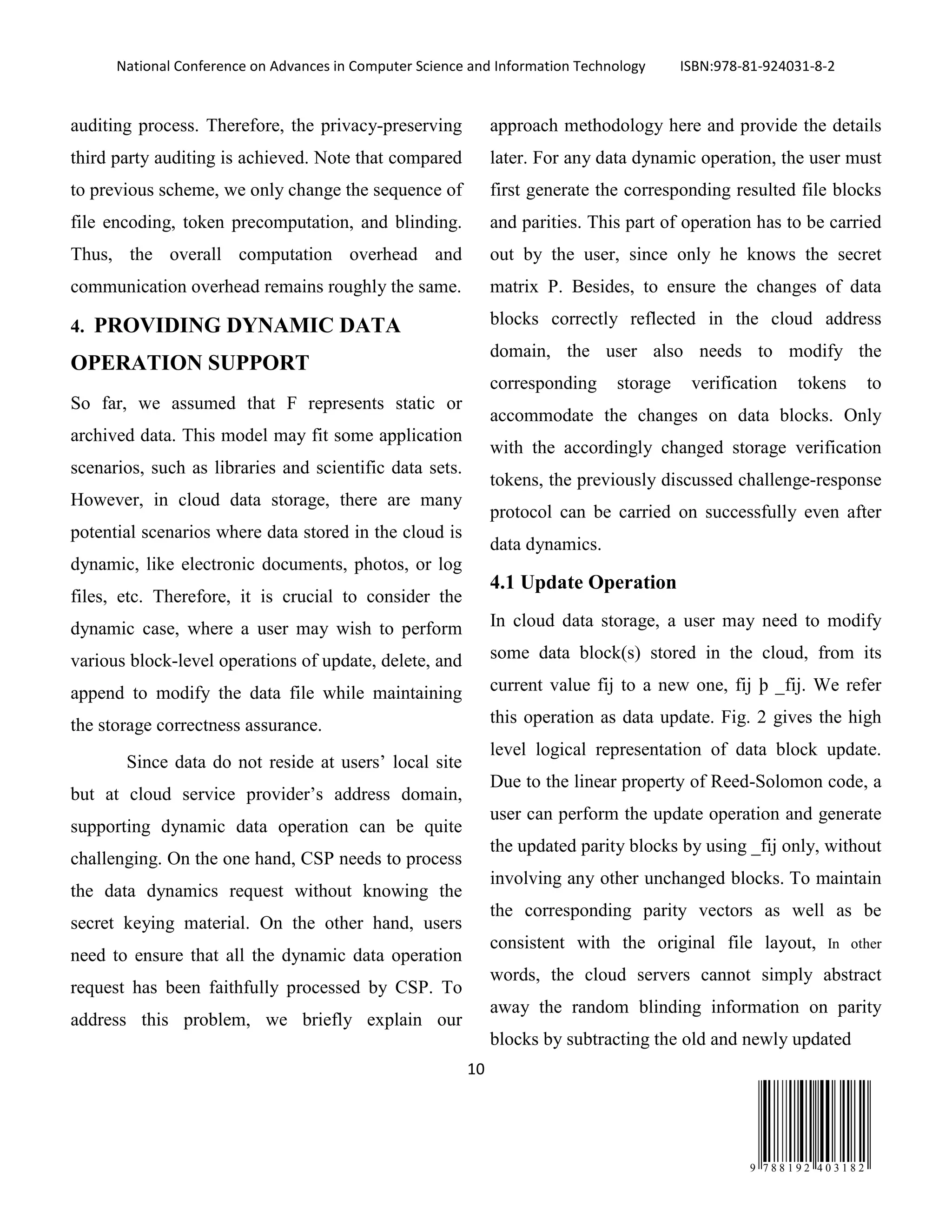

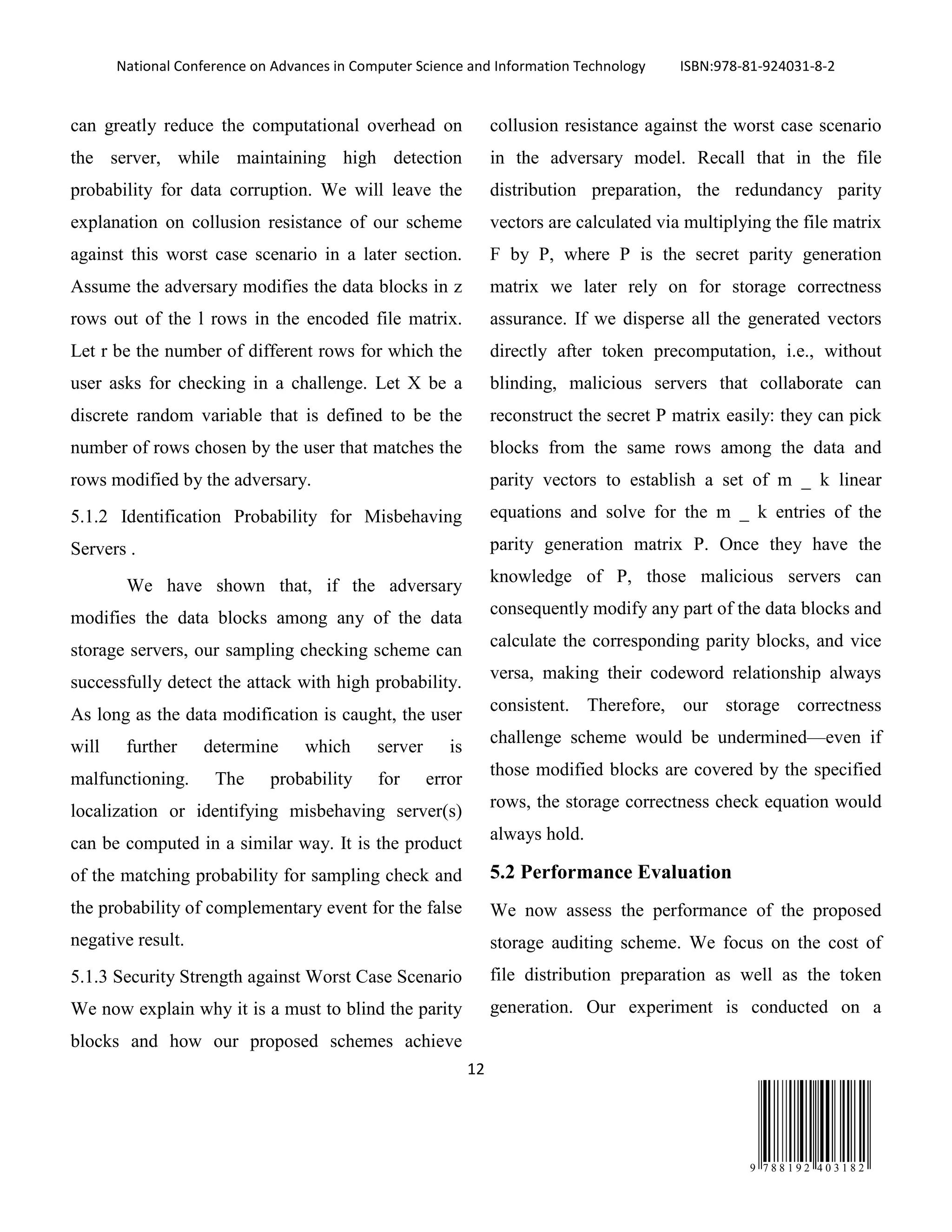
![National Conference on Advances in Computer Science and Information Technology ISBN:978-81-924031-8-2
13
9 7 8 8 1 9 2 4 0 3 1 8 2
system with an Intel Core 2 processor running at
1.86 GHz, 2,048 MB of RAM, and a 7,200 RPM
Western Digital 250 GB Serial ATA drive.
Algorithms are implemented using open-source
erasure coding library Jerasure written in C. All
results represent the mean of 20 trials.
5.2.1 File Distribution Preparation
As discussed, file distribution preparation includes
the generation of parity vectors (the encoding part)
as well as the corresponding parity blinding part.
We consider two sets of different parameters for the
ðm; kÞ Reed-Solomon encoding, both of which
work over. shows the total cost for preparing a 1
GB file before outsourcing. In the figure on the left,
we set the number of data vectors m constant at 10,
while decreasing the number of parity vectors k
from 10 to 2.
5.2.2 Challenge Token Computation
Although in our scheme the number of verification
token t is a fixed priori determined before file
distribution, we can overcome this issue by
choosing sufficient large t in practice. For example,
when t is selected to be 7,300 and 14,600, the data
file can be verified every day for the next 20 years
and 40 years, respectively, which should be of
enough use in practice. Note that instead of directly
computing each token, our implementation uses the
Horner algorithm suggested in to calculate token i
from the back, and achieves a slightly faster
performance.
6. RELATED WORK
Juels and Kaliski Jr. [10] described a formal “proof
of retrievability” (POR) model for ensuring the
remote data integrity. Their scheme combines spot-
checking and errorcorrecting code to ensure both
possession and retrievability of files on archive
service systems. Shacham and Waters built on this
model and constructed a random linear function-
based homomorphic authenticator which enables
unlimited number of challenges and requires less
communication overhead due to its usage of
relatively small size of BLS signature. Later in their
subsequent work, Bowers extended POR model to
distributed systems. However, all these schemes are
focusing on static data. The effectiveness of their
schemes rests primarily on the preprocessing steps
that the user conducts before outsourcing the data
file F. Any change to the contents of F, even few
bits, must propagate through the errorcorrecting
code and the corresponding random shuffling
process, thus introducing significant computation
and communication complexity. Recently, Dodis et
al. gave theoretical studies on generalized
framework for different variants of existing POR
work. Ateniese et al. [11] defined the “provable
data possession” (PDP) model for ensuring
possession of file on untrusted storages. Their](https://image.slidesharecdn.com/s-150310051744-conversion-gate01/75/S-A-kalaiselvan-toward-secure-and-dependable-storage-services-13-2048.jpg)

![National Conference on Advances in Computer Science and Information Technology ISBN:978-81-924031-8-2
15
9 7 8 8 1 9 2 4 0 3 1 8 2
scheme only works for encrypted files, and auditors
must maintain long-term state. Schwarz and Miller
proposed to ensure static file integrity across
multiple distributed servers, using erasure-coding
and block-level file integrity checks. We adopted
some ideas of their distributed storage verification
protocol.
7. CONCLUSION
In this paper, we investigate the problem of data
security in cloud data storage, which is essentially a
distributed storage system. To achieve the
assurances of cloud data integrity and availability
and enforce the quality of dependable cloud storage
service for users, we propose an effective and
flexible distributed scheme with explicit dynamic
data support, including block update, delete, and
append. We
rely on erasure-correcting code in the file
distribution preparation to provide redundancy
parity vectors and guarantee the data dependability.
By utilizing the homomorphic token with
distributed verification of erasurecoded data, our
scheme achieves the integration of
storagecorrectness insurance and data error
localization, i.e., whenever data corruption has been
detected during the storage correctness verification
across the distributed servers, we can almost
guarantee the simultaneous identification of the
misbehaving server(s). Considering the time,
computation resources, and even the related online
burden of users, we also provide the extension of
the proposed main scheme to support third-party
auditing, where users can safely delegate the
integrity checking tasks to thirdparty auditors and
be worry-free to use the cloud storage services.
Through detailed security and extensive experiment
results, we show that our scheme is highly efficient
and resilient to Byzantine failure, malicious data
modification attack, and even server colluding
attacks.
ACKNOWLEDGMENTS
This work was supported in part by the US National
Science Foundation under grants CNS-1054317,
CNS- 1116939, CNS-1156318, and CNS-1117111,
and by an Amazon web service research grant. A
preliminary version [1] of this paper was presented
at the 17th IEEE International Workshop on Quality
of Service (IWQoS ’09).
REFERENCES
[1] C. Wang, Q. Wang, K. Ren, and W. Lou,
“Ensuring Data Storage Security in Cloud
Computing,” Proc. 17th Int’l Workshop Quality of
Service (IWQoS ’09), pp. 1-9, July 2009.
[2] Amazon.com, “Amazon Web Services (AWS),”
http://aws. amazon.com, 2009.](https://image.slidesharecdn.com/s-150310051744-conversion-gate01/75/S-A-kalaiselvan-toward-secure-and-dependable-storage-services-15-2048.jpg)
![National Conference on Advances in Computer Science and Information Technology ISBN:978-81-924031-8-2
16
9 7 8 8 1 9 2 4 0 3 1 8 2
[3] Sun Microsystems, Inc., “Building Customer
Trust in Cloud Computing with Transparent
Security,” https://www.sun.com/
offers/details/sun_transparency.xml, Nov. 2009.
[4] K. Ren, C. Wang, and Q. Wang, “Security
Challenges for the Public Cloud,” IEEE Internet
Computing, vol. 16, no. 1, pp. 69-73, 2012.
[5] M. Arrington, “Gmail Disaster: Reports of Mass
Email Deletions,”
http://www.techcrunch.com/2006/12/28/gmail-
disasterreportsof- mass-email-deletions, Dec. 2006.
[6] J. Kincaid, “MediaMax/TheLinkup Closes Its
Doors,”http://
www.techcrunch.com/2008/07/10/mediamaxthelink
up-closesits-doors, July 2008.
[7] Amazon.com, “Amazon S3 Availability Event:
July 20, 2008,” http://status.aws.amazon.com/s3-
20080720.html, July 2008.
[8] S. Wilson, “Appengine Outage,”
http://www.cio-weblog.com/
50226711/appengine_outage.php, June 2008.
[9] B. Krebs, “Payment Processor Breach May Be
Largest Ever,”
http://voices.washingtonpost.com/securityfix/2009/
01/ payment_processor_breach_may_b.html, Jan.
2009.
[10] A. Juels and B.S. Kaliski Jr., “PORs: Proofs of
Retrievability for Large Files,” Proc. 14th ACM
Conf. Computer and Comm. Security (CCS ’07),
pp. 584-597, Oct. 2007.
[11] G. Ateniese, R. Burns, R. Curtmola, J. Herring,
L. Kissner, Z. Peterson, and D. Song, “Provable
Data Possession at Untrusted Stores,” Proc. 14th
ACM Conf. Computer and Comm. Security (CCS
’07), pp. 598-609, Oct. 2007.
[12] M.A. Shah, M. Baker, J.C. Mogul, and R.
Swaminathan, “Auditing to Keep Online Storage
Services Honest,” Proc. 11th USENIX Workshop
Hot Topics in Operating Systems (HotOS ’07), pp.
1-6, 2007.
[13] M.A. Shah, R. Swaminathan, and M. Baker,
“Privacy-Preserving Audit and Extraction of Digital
Contents,” Cryptology ePrint Archive, Report
2008/186, http://eprint.iacr.org, 2008.
[14] G. Ateniese, R.D. Pietro, L.V. Mancini, and G.
Tsudik, “Scalable and Efficient Provable Data
Possession,” Proc. Fourth Int’l Conf.Security and
Privacy in Comm. Netowrks (SecureComm ’08),
pp. 1-10, 2008.
[15] Q. Wang, C. Wang, J. Li, K. Ren, and W. Lou,
“Enabling Public Verifiability and Data Dynamics
for Storage Security in Cloud Computing,” Proc.
14th European Conf. Research in ComputerSecurity
(ESORICS ’09), pp. 355-370, 2009.](https://image.slidesharecdn.com/s-150310051744-conversion-gate01/75/S-A-kalaiselvan-toward-secure-and-dependable-storage-services-16-2048.jpg)